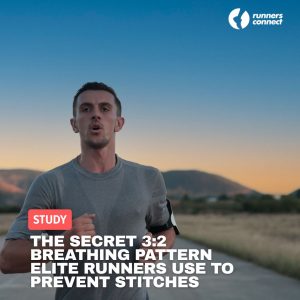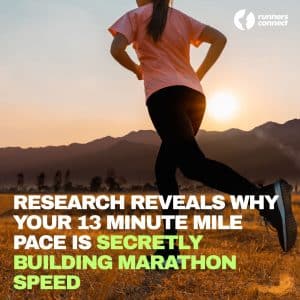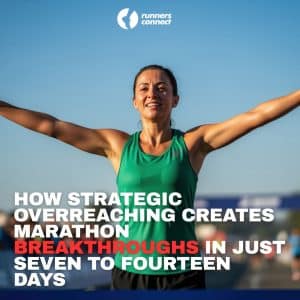Running economy is one of the key determinants of your performance.
In fact, I’d go as far as saying it’s one of the most critical components to how fast you can race the marahon.
In short, your running economy dictates how fast you can run for a given energy expenditure.
In this content, when we talk about energy, this is “energy” in the literal sense of calories from food.
So, why is this running economy so important, especially in the marathon?
Well, a more economical runner can go faster for the same rate of caloric expenditure, or equivalently, can run further for the same amount of energy.
To help explain this concept further, and to help you improve your own running economy, we’re going to look at all the available reasearch on the what, why and how of running economy.
What is running economy, and how is it measured?
In classical models of running performance, running economy is one of the three key components of your performance (the others being VO2max and lactate threshold) [1].
Running economy is much like gas mileage for cars, in that a less efficient runner needs to consume more oxygen and burn more “fuel”—i.e. calories—to cover a given distance.
Confusingly, while gas mileage for cars is expressed as distance per unit of fuel (e.g. 30 miles per gallon), running economy is measured using the inverse: fuel cost per unit distance.
So, in the context of running economy, lower is actually better.
Running economy is typically expressed relative to your body weight. This is because body weight impacts energy cost in two opposing ways: while more weight obviously means more mass you need to transport over a given distance, it also means you have a bigger heart, greater lung volume, and more powerful leg muscles.
So, in scientific research, running economy is typically quantified as milliliters of oxygen, per kilogram of body weight, per kilometer of distance covered—for example, “197 mL/kg/km” (that happens to be my running economy at marathon pace!).
It’s also possible to measure running economy as food calories per unit distance covered, though oxygen cost is the more common and (almost) equivalent unit in studies on runners.
When it comes to actually assessing running economy in the lab, it’s much easier to test than VO2max or lactate threshold. All you need to measure is a runner’s oxygen consumption at the end of a six-minute bout of running at a speed that’s at least a bit slower than half marathon pace or so.
Why does it need to be slower than half marathon pace?
The one catch to measuring running economy is that it’s only possible to measure at speeds where essentially all of your energy is coming from the aerobic system. Once your anaerobic system starts pumping out energy at 10k, 5k, or mile pace, there’s no way to account for that extra energy.
Running speed and running economy
Running economy has one very curious property—it hardly changes at all as a function of speed!
While you do have to spend more energy per unit time to run faster, the fact that you cover more distance in the same amount of time means the effects of speed cancel out nearly perfectly.
Note that it’s nearly perfect, not totally perfect.
Both recreational and elite runners do get modestly more efficient at speeds between 8:00/mi and 6:00/mi, compared to speed faster or slower than that range, according to a 2018 study by researchers at Loughborough University in the UK [2].
Still, the effect is much smaller than that for walking, which gets vastly less efficient the further away you get from your preferred walking speed.
What determines your running economy?
When you picture an efficient runner, you probably imagine a lean athlete moving smoothly and spending very little time on the ground.
However, running economy turns out to be much more complex and counterintuitive than you’d expect—even seemingly-obvious factors like body composition and time spent on the ground explain only a small fraction of the variation in running economy across individuals.
Take body composition as an example. While it makes sense that a lean, trim runner should be more efficient than a larger-framed runner, research shows that this effect is quite weak.
A study published in 2020 found that a comprehensive combination of body size measurements (wrist size, waist circumference, body fat percentage, and so on) accounted for only 22-35% of the total variation running economy in a sample of nearly 100 runners spanning a wide range of body sizes and running abilities [3].
What about running form?
The same research group also published another paper investigating whether factors like vertical oscillation, ground contact time, cadence, and joint angles could explain more of why running economy differs from one runner to the next.
Again, though, none of these aspects of running form explained more than 25% of the variation in running economy [4].
It’s useful to contrast the difficulty of predicting running economy against that of VO2max, another major component of running performance.
For a runner’s VO2max, just two variables—total blood volume and maximum cardiac output—can account for over 90% of the variation in VO2max across athletes [5].
What makes running economy so hard to understand?
The main reason is that your running economy is highly dependent on the dynamics of individual muscle fibers.
The energetic cost of producing muscle force depends on the length of the muscle fiber, the speed of the muscular contraction, and the type of the fiber (fast or slow-twitch) [6]—all factors that can vary in an extremely hard-to-predict fashion.
How to improve running economy
Even though running economy is not nearly as well-understood as other performance factors like VO2max, that doesn’t mean there’s no way to improve it.
Research suggests there are three reliable ways to improve running economy:
- high-volume training
- heavy weight lifting
- plyometric exercises.
Cross-sectional studies on runners suggest that more running experience translates to better running economy. In this sense, efficient running is a “skill” that can be improved with long-term practice.
One case study detailing the physiological profile of former women’s marathon world record holder Paula Radcliffe found she had an amazing 15% improvement in her running economy over the course of eleven years of training [7].
Experimental studies also suggest that both continuous runs and long intervals are effective at improving running economy, to the tune of about 3% over six weeks in recreational runners (though interestingly, short high-speed intervals are less effective) [8].
Heavy lifting and plyometrics training (i.e. explosive jump training) also improve running economy, according to a 2016 meta-analysis that pooled data from 16 different individual studies [9].
There are two plausible explanations for why these types of strength training improve running economy.
The first is that they increase the stiffness of tendons like the Achilles and patellar tendons, enabling more efficient force production in your muscles.
A second possibility is that these types of exercises increase your body’s ability to maximally recruit your muscle fibers, opening up the possibility of more effective muscle recruitment strategies during running.
Both of these mechanistic explanations lead to the same conclusions: the lifting you do must be heavy, lower-leg exercises like squats and calf raises, and your plyometrics routine should consist of explosive, maximal-effort jumping exercises.
High intensities—either in the form of heavy weights or explosive jumping—are necessary to increase tendon stiffness and to increase maximal muscle fiber recruitment; lower-intensity strength training is not effective, even when done with a high number of reps [10].
One thing that doesn’t improve running economy? Changing your running form.
Research consistently indicates that your body already chooses how to run largely in an effort to minimize the metabolic cost of running. As a result, simple changes like increasing or decreasing your step length typically make your running economy worse, not better.
Even when you’re fatigued, evidence suggests that your fatigued running form is the most economical, given the fatigue-induced constraints on your body [11].
Conclusion
Running economy is an important determinant of performance, but it’s much less well-understood than factors like VO2max.
Even seemingly-obvious things like body size, body fat percentage, and various aspects of running form only explain a small fraction of the variation in running economy across different athletes. If you want to improve your economy, you can use a combination of high-volume continuous runs, long intervals, heavy lifting, and plyometrics.
Don’t bother with changes to your running form, though—your body already aims to optimize for efficiency, so any conscious changes you make are likely to make you less efficient.




